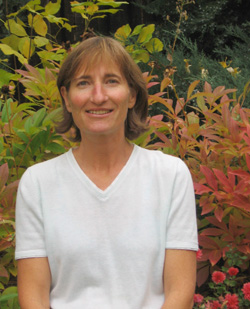Q&A: Colorado Green Building Guild
 In 2004, a group of building professionals decided to form the Boulder Green Building Guild (BGBG) to help educate the community on the benefits of green building after Boulder created mandatory green building standards on new residential structures and renovations larger than 500 square feet. Then, in 2011, the organization’s board of directors voted to transform the BGBG into the Colorado Green Building Guild (CGBG) to create a broader organization. It now has more than 500 members made up of contractors, architects, realtors and material suppliers. Green Building News spoke with the organization’s president, Sandra Weeks, and Executive Director Julie Herman about CGBG’s involvement in the community and how other communities can use it as a model to start their own guild.
In 2004, a group of building professionals decided to form the Boulder Green Building Guild (BGBG) to help educate the community on the benefits of green building after Boulder created mandatory green building standards on new residential structures and renovations larger than 500 square feet. Then, in 2011, the organization’s board of directors voted to transform the BGBG into the Colorado Green Building Guild (CGBG) to create a broader organization. It now has more than 500 members made up of contractors, architects, realtors and material suppliers. Green Building News spoke with the organization’s president, Sandra Weeks, and Executive Director Julie Herman about CGBG’s involvement in the community and how other communities can use it as a model to start their own guild.
Q: What is the overall goal of CGBG?
Weeks: It totally aligns with the vision of the guild. We’re an association of building professionals dedicated to promoting healthier, resource-efficient homes and workplaces. We strive to advance the craft of green building and support other members on their environmentally responsible endeavors. We try to be the focal point for communication on green building, and we want to empower people to build healthy resource-efficient communities.
Q: What specifically does CGBG provide for its members to help them achieve green building initiatives?
Weeks: We provide high-quality education; networking across the different industry groups, such as architects, contractors and vendors; promote peer-to-peer interaction; give members access to CEUs (or continuing education credits); and work with local governments on coaching and pilot programs. We try to be as current as possible with information regarding green building business.
Herman: We also connect our contractors to where the programs, financing and funding is so that they can get involved and leverage these programs with their consumers.
Q: What are the outlets for education that the CGBG provides?
Herman: Primarily it’s face-to-face opportunities. A lot of our education becomes highly valuable due to the interactions with the experts in the field. We have presentations, but also panels to get dialogue more from a host of perspectives and our attendees. Lots of our members have been working in the field for a long time, so when they can share their questions and expertise it makes the experience richer for everyone. We have also started to film training sessions and are posting them online to explore if this has value.
Q: What kind of support does the CGBG get from local governments, and how does that support help members?
Herman: In Boulder, for instance, it means that we create dialogue between local code officials and local government staff so everyone can share what their challenges are and what they need from our each other. Code staff, for example, can say that they see contractors aren’t meeting code well in a specific area and will ask us if we can initiate training on that issue. Both the city and county provide financial resources to help make sure our industry is prepared to understand their building codes and help meet their goals on greenhouse gas reduction. We also share the community goals with contractors and provide the resources they need to help meet those goals.
Q: Do you see the CGBG moving from a state level to a national level?
 Herman: The potential for it to be a model for local- or a state-wide organizations is there. Communities would need an interest from contractors who see the value of green building and an industry association that supports them. We’re a local grassroots organization, and the reason we were so successful in Boulder County is we had a combination of jurisdiction support to move the industry forward, as well as industry of professionals who were interested in finding ways of putting themselves ahead of the curve.
Herman: The potential for it to be a model for local- or a state-wide organizations is there. Communities would need an interest from contractors who see the value of green building and an industry association that supports them. We’re a local grassroots organization, and the reason we were so successful in Boulder County is we had a combination of jurisdiction support to move the industry forward, as well as industry of professionals who were interested in finding ways of putting themselves ahead of the curve.
Q: What is the first step that other states can take to create an organization like CGBG?
Herman: I think that the most successful approach would be working on a local level, seeing if there is interest and then sharing the model of how they’re growing in one community with other similar communities. It really is about being local, and it’s more effective to start in a grass roots way than to have something that starts from the top down. A successful Guild ultimately has to have ownership by local contractors who see value in it.
Q: What is currently happening in the CGBG that is relevant on a state level? On a national level?
Herman: We’re partnering with local utilities and helping share their incentives and rebates. That’s a model that can really be replicated. The role that contractors play in terms of green building and getting the uptake of utility demand side management programs, is one of the cornerstones to success. It’s the contractors that have to make sure the program’s goals are met by doing quality work and selling the incentives and rebates to consumers.
On a national level, everyone has to make sure that contractors are trained well to do the quality work it takes to ensure the goals of a programs are met. Contractors are the ones that are working directly with consumers and can make sure that consumers are aware of their options. For example, contractors have the opportunity to show a building owner that they could do much more than they originally intended. In many cases they can sell the idea that it is in their client’s economic interest to take advantage of incorporating energy-efficient upgrades that they had not considered. Contractors need to have the expertise to make sure they can detect these opportunities.
Q: What is your response to recent studies that say green building is on the rise, despite the economy? Do you think this is true, and from your point of view, why do you think it is?
Weeks: The reason is because there’s a lot more awareness. Once people are aware, that stimulates demand; once you stimulate demand, the supplies are greater and costs go down. It’s a cycle that improves the industry.
Q: A lot of architects and general contractors have admitted to not working towards LEED certification as much, although green building elements are still being pursued. Do you think this is common, and why do you think they’re not working to get that certification anymore?
Herman: That’s absolutely true for our area for a couple of reasons. We had a huge infusion of ARRA funding that focused on energy-efficiency upgrades but didn’t involve LEED. That’s where a lot of contractors have spent their time in the past few years. I think the financial challenges and time commitment involved in getting LEED can be a big barrier, and [contractors] are realizing that they can take that money to invest in other green building opportunities. I think LEED will continue to play an important role, especially in larger communities and in the commercial sector.
